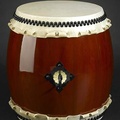In the last ten years, I’ve been surveying classes, rehearsals, and presentations of musical clubs belonging to the Associação Okinawa do Brasil (Okinawa Association of Brazil, or OAB), the Associação Brasileira de Música Clássica Japonesa (Brazilian Association of Japanese Classical Music, or ABMCJ), and the group Miwa. The clubs of the first association present a local repertoire – from the Ryûkyû region – while those of the second have opted for a national repertoire.
The specific participation of children is rare, except in the membranophone taiko schools of the Okinawa Association. In Ikuta schools – those of the group Miwa and the Seiha Brasil Group (belonging to the ABMCJ) that teach Koto (Image 1) – the number of children ranges from four to six girls. And in the Ryûkyû schools, four children were learning sanshin, and only one was learning to play kutû. In the Kinko school, there is only one child learning shakuhachi, along with his grandfather.
This article concerns musical transmission, highlighting the speed and efficacy of aural memory strategies, the musical notation system, and mnemotechnical methods. By examining the reasons, motivations, and projections revolving around music learning and teaching behaviors, it was noticed that classes of traditional musical instruments play an important role not only in esthetic refinement, reinforcement of music and/or dance learning, and approximation and deepening of ancestral cultural identities, but they also help preserve ethical, emotional, and numeric stability in the group in question.
This article is a spin-off of research conducted in the Nikkei community (OLSEN, 1983, SATOMI, 1998 and 2004) in the city of São Paulo, with musical clubs tied to three entities: the Okinawa Association of Brazil (AOB), the Brazilian Association of Classical Japanese Music (ABMCJ), and the group Miwa. The first focuses on teaching the lute sanshin, the zither kutû (Okinawan pronunciation of koto) and the drum têku or taiko, musical instruments of the vernacular repertoire that include the musical repertoire of both the court and the rural areas on the islands Ryûkyû, in the southern tip of Japan. The others focus on the national repertoire: from the Ikuta and Yamada schools for koto; from the Tôzan and Kinko schools for the shakuhachi flute.
In regard to its methodological procedure, this approach attempts to broach the issues of motivation, behavior, musical values, and the description of musical experiences as suggested by Swanwick (1983. p. 203). In the koto schools, field research is close to active observation, of “having an active role,” as mentioned by Coulon (1995, p. 75). Also, the theoretical presuppositions would be in accordance to the cited references.
In the last ten years, even though I have limited the topic to schools of sanshin and koto, I have had the opportunity to observe, with less intensity, the classes, rehearsals, and presentations of têku and shakuhachi. In the general scope of my research, I’ve noticed that children and young people learn traditional Japanese instruments in schools of taiko, koto, sanshin, and shakuhachi.
SCHOOLS OF THE OKINAWA ASSOCIATION OF BRAZIL
The AOB has an intense musical activity due to the existence of eight music schools: four of koten music – which I call anthological music, for it consists of an established repertoire, registered in written compilations; two of minyô, so-called “folkloric” music; and two of taiko. In addition to solving distance-related issues – generally speaking, one school serves the northern area of the city while another serves the eastern area – parity among the schools lead to a healthy rivalry, contributing to the preservation of tradition. Those schools can be grouped according to instruments, type, or generation. Most practitioners of the koten music are older, with the men playing sanshin and the women kutû. Among the minyô players, working-age adults are the majority, without any distinction in regard to instrument or type. Nevertheless, the focus of the present discussion is on the têku schools, where participation is comprised exclusively of children and young people.
At the AOB parade celebrating of the 90th Anniversary of Japanese Immigration to Brazil in June 1998, approximately one hundred taiko rumbled on Galvão Bueno toward the Praça da Liberdade, the main thoroughfares of the Japanese district, accompanying a modernized – or recreated – repertoire recorded by professional singers from the island of Okinawa. The uniformity of the costumes contrasted with the variety of sizes of both the drums and their players, who ranged from the age of five to 25. Younger children carried the smaller têku, such as the membranophone with a skin called paranku, or the ku-dêku, with double skin and a lacing system. Teenagers and other young players usually carried the deep-sounding taiko ô-deku, with double skin, in the form of a barrel, and with a system of tacks. The eyes of the smaller children were always focused on the leader of each group so as not to lose their concentration or the harmony of the choreographic movements and, consequently, of the beating of their drums.
Nearly every drum was made by Professor Naohide Urasaki, who also happens to be solely responsible for their storage and maintenance. He is a great Ryûkyûan culture dynamo, especially in the Vila Carrão district, a suburb in the eastern section of the city that has the largest concentration of Okinawans in the country. Professor Urasaki comes from a background similar to those of many other countrymen living in Vila Carrão. In 1957, he emigrated from Naha, the Okinawan capital, to Bolivia, where he grew bananas after a failed attempt to grow rice. In 1961, he arrived in Brazil, where he began working in apparel manufacturing, and it was only in the following year that he became established in the city’s vegetable trade. As an enculturating agent, he initially organized a theater group, going as far as staging two plays per year – earlier, in Okinawa, he had worked in scenic and choreographic arts. He also began teaching dance and in 1987 he formed the group Hananokai, which consists of nine dance teachers in São Paulo and Campinas. That same year, Mitsufumi Shimabukuro’s school allowed him to teach taiko. In 1989, he began to manufacture taiko after being invited to dance on the campus of a Tokyo university. With this new qualification, the obstacle of instrument unavailability was surpassed – one of the essential factors for the introduction of traditional music, as mentioned by Sutton (1983, p. 80) – and thus Professor Urasaki’s taiko school was born.
Currently, his school has more than 60 students from the Ipiranga, São Mateus, and Santa Clara districts, from the Vila Carrão itself, and from the city of Campinas. Classes are taught at his own home – which boasts a replica of a Japanese lagoon in its internal and external garden, where the children can appreciate the landscape and the fish, a bucolic vision of that ancestral microcosm – in a room reserved especially for the activity, located on the upper floor where can be found the taiko, stools, books, and audio and video tapes at the disposal of the students.
Class is divided up into two sections. In the first, the students learn to play the pair of drums ufudêku and kudêku (Image 2), accompanying a group of five pieces from the anthological repertoire, in accordance with both a professional recording and the teacher himself, who plays while standing. The learning process is through imitation, for the Japanese take very seriously the meaning of words such as shihan (master), whose literal meaning is “model.” During the break, after getting back and putting away the têku and other materials in the same way they had found them prior to class, the oldest student or the teacher’s assistant takes charge of serving the eagerly awaited beverages and chips offered by the teacher. Then, the seriousness is replaced by some loosening up. Some have fun with games and chats, other children check the collection of modern CDs, while others pay attention to the teacher, who shows amply illustrated books displaying native dances while having a bilingual conversation; in other words, the children speak Portuguese, whereas the teacher speaks Japanese.
In the second half, the children play pieces of modernized vernacular music performed by pop groups from Okinawa, such as Rinken Band and Nenes Ashibi. This time around, the children playing the paranku and the adolescents playing the ô-deku accompany the beats and steps on a video recording; in other words, they are teleguided by a virtual model, a young man who is probably the monitor of groups showcased in the Kokusai Matsuri Daiko (Taiko National Festival) in Okinawa.
The details expounded here form an attempt to clarify the setting for the introduction of discipline, hierarchy, and even a healthy dosage of competitiveness, without strictness or austerity on the part of the professor. Parenthetically speaking, it can be noticed that, contrary to tendencies found in other traditional Japanese schools, the descendents of the professors don’t follow the activities of their predecessors. What happens is that in order to assist the parents’ dedication to the activities of the province’s social circle, the children are precociously introduced to the family’s business affairs, thus having to renounce their own learning. Yet, I believe that in this reality it is more relevant to note the enculturating agent’s important communal behavior. In a manner similar to that of Brazilian Indians, it is as if the teacher adopted all of the community’s children as if they were his own, without worrying about the territoriality of the family heritage, teaching with equanimity to all his apprentices, without preferences or distinctions.
When asked about his goal in teaching taiko, Professor Urasaki said that the primary purpose of the têku teaching process is to refine dance, for “the good dancer must know certain basic taiko beats, just like a good musician should understand, or rather, know how to dance.” But in other informal conversations, I believe that the Professor mentioned two highly important core issues to encourage the learning of têku. At the end of a class in July 1997, Professor Urasaki remarked: “And that’s how we’re going to put Okinawan music into the heads of our children. Even without understanding the song lyrics, they will learn the rhythm and will end up absorbing the culture of their ancestors.”
Oftentimes, the attachment to traditions or the goal of cultural preservation belie an intention to preserve the population itself, as remarked by Bruno Nettl (1983, p. 227) in his study on ethnomusicology. In another instance, Urasaki confessed his hidden motivation for teaching taiko, reinforcing the endogamy suggested by Nettl: “I have encouraged children to learn taiko because deep inside I’d like to see them married to individuals from their own community... Naturally, because of our past and history.” (Urasaki, August 1997).
It is worth remembering that Ryûkyû was an independent kingdom until the 14th century. From then on, it went through numerous periods of subordination to the Chinese and Japanese empires, and was taken by the United States during World War II until it opted to be annexed to Japan, a handover that was to take place only in 1972.
In the realm of classical music schools, I noted the presence of Leandro Satoru Saito, a dancing boy wonder, who learned classical dance through a virtual model, i.e., through recordings of Okinawan professional dancers, since the age of 4. He is the pride of AOB, mainly at the Casa Verde branch, located in the city’s northern section – the second largest concentration of Okinawans in São Paulo. His learning of sanshin or kutû from the anthological repertoire reinforces the primary goal pointed out by Professor Urasaki: that of learning the musical instrument in order to refine one’s dancing skills.
Another young star rising at Casa Verde is the boy Vítor Arashiro, who, at the age of nine, is already considered a wonder in both cavaquinho [a small Brazilian guitar] and sanshin playing. His musical adeptness with the cavaquinho has helped in teaching him sanshin with Professor Takashi Komesu of the Grupo de Preservação de Minyô (Group for the Preservation of Minyô).
In the São Mateus district, located in the eastern section of São Paulo, there is a pop group called Ton-ton-mi (Image 3), a band with professional recognition in Okinawa and that has already recorded a number of CDs. They perform traditional songs with modern arrangements for sanshin, bass guitar, and keyboards. The group is comprised of five youths who began learning sanshin and/or taiko at a very early age. According to other students at the Minyô Association in the Vila Carrão, learning consists of being present in class, for the teacher only plays and sings along without providing any theoretical or practical comments. When the teacher is dissatisfied, all he does is ask for a replay of the segment or piece.
SCHOOLS OF JAPANESE CLASSICAL MUSIC
Children were absent from the performances of the Brazilian Association of Japanese Classical Music. However, in the first meeting organized by grandmaster Iwami Baikyoku V – at his beach house (Image 4), gathering teachers and their top assistants – there was a nine-year-old Eurasian boy playing the favorite piece from the sôkyoku repertoire, “Rokudan.” The boy, Maurício Mazzuco, is Professor Iwami’s grandson, the promise of a sixth lineage in the continuity of the Kinko-ryû (school or style), for he was initiated at the same age that his grandfather began learning shakuhachi.
In the koto schools, children could be found in the segments of the Ikuta school – specifically in the group Miwa and the Seiha Brasil Koto Group, where the teachers are Miriam Sumie Saito and Tamie Kitahara, respectively. In order to deal with commuting and security issues, the teachers do their utmost to make life easy for their students. As the youngest Ikuta-ryû teacher, Kitahara is the most willing to teach at the students’ homes. Carrying koto, sangen, musical arrangements, and a cell phone, she crisscrosses the city from one extreme to the other using her own modes of transportation, thus sparing the neurons and adrenaline of her students while taking risks in a missionary attitude as she herself explains in a February 2003 interview:
You know, in São Paulo, since everything is far away, with traffic jams everywhere, and it’s dangerous to leave home. So, if I didn’t decide to go to the students’ homes, they probably wouldn’t be learning traditional music. For me, teaching is a mission here on Earth.
Professor Saito travels weekly to the Shiinomi School, where the chief activity is teaching Japanese to children and young people. In 2000, there were 7 students, but now there are only 4. The children spend all Saturday long at school whenever they take other courses such as design, origami, calligraphy, and choral singing. In the room decorated with the children’s drawings and pictures from the school’s more than fifty years of history, there are three o-koto (Image 5).
Since the children are encouraged by their mothers to learn koto, I gathered from them several important comments about their motivations or reasons for learning to play the instrument (SATOMI, 2004, p. 140):
One can never spend too much time learning. Learning koto helps children to memorize the language, getting in contact with their roots in a pleasurable manner. It’s very good because there are so many risks for today’s youth; it keeps children busy, preventing the possibility of their hanging out with the wrong crowd, addictions – in sum, of doing everything that isn’t good.
On the top layer we have as motivation the reinforcement of learning Japanese, which covers the layer of having the students learn their own culture. In the inside layers, lies the idea that the “we” – the family and social choices – will guarantee security and prevent youth’s problems. But in this regard, I believe that the search for security, and for ethical and moral stability is stronger than the feeling of belonging, for the problem-plagued world does not exist exclusively in “their” world.
The locale for the transmission within a transterritorialized context offers a cozy ambiance similar to that of the students’ own homes. At lunch break, there is always the possibility that the students will grasp an understanding of the teacher’s lifestyle in a manner that is closer to the original concept of traditional learning.
Basically, there are three strategies for the teaching of traditional Japanese music: repetition according to a model, aural memory, and mnemotechnical methods. When introducing the instrument, the teacher tries to teach pieces from the traditional repertoire, preferably those the student already knows so as to make use of his aural memory. Therefore, when the song is already known (or easily memorized), the notations serve as mere written references while the student learns the tablature codes without the need for theorizations. The musical notation employs ideograms and syllabaries from the Japanese writing system; even so, the lack of either knowledge or understanding of Japanese writing is not an obstacle to learning.
In order to facilitate the lecture, during the students’ first steps Professor Miriam writes on a crepe ribbon the numerical ideograms corresponding to the chords, placing them below the chords. The initial pieces have a small range. For instance, the well-known “Sakura” tune requires only 7 chords between the third and ninth chords. The rhythmic notations follow a logical and mathematical arrangement in the bar system, but the mnemonics solfège (melodic, rhythmic, and timbre) of the teacher’s own instrument is what actually guides the student. While observing the speed of learning rhythmically complex passages for beginners – with the punctuated rhythms, speed, and timbre effects – I was able to verify the efficacy of mnemonics that David Hughes (1999, p. 57) advocates thus:
Mnemonic methods are still being used in traditional teaching systems in Japan, Korea, and China [...]. Generally speaking, the vowels are related to factors of pitch, duration and intensity, whereas the consonants reflect aspects of attack or diminution. Although they may seem somewhat inconsistent, these systems work well and in fact are better teaching tools than many other types of written notations.
By examining the reasons, motivations, and projections revolving around teaching and learning behaviors, one can conclude that the classes of traditional instruments within a transterritorial context play an important role not only in terms of esthetic refinement, reinforcement of language and dance learning, or the reinforcement of one’s ancestral identity, but they also serve to preserve the moral, ethical, and numerical stability of the ethnic group in question.
BIBLIOGRAPHY
COULON, Alain. Ethnomethodology and Education. Translated by Guilherme Teixeira. Petrópolis: Vozes, 1995.
HUGHES, David. Common elements in East Asian oral mnemonic systems. In: WORLD CONFERENCE OF THE INTERNATIONAL COUNCIL FOR TRADITIONAL MUSIC, 35,1999. Hiroshima. 35th World Conference of ICTM: Abstracts. Tóquio: ICTM, 1999, p. 57.
NETTL, Bruno. The study of ethnomusicology: twenty-nine issues and concepts. Urbana; Chicago: University of Illinois, 1983.
OLSEN, Dale. Japanese music in Brazil. Journal of the Society for Asian Music. Austin. vol. 14, n. 1. p. 111-31, 1982.
SATOMI, Alice Lumi. “Raindrops on the roof...”: Ryûkyû music in São Paulo. Masters dissertation in music (ethnomusicology). Salvador: Universidade Federal da Bahia, 1998.
______ Dragon talking...: ethnicity, ideology and cultural heritage through koto music in Brazil. Doctoral thesis in music (ethnomusicology). Salvador: Universidade Federal da Bahia, 2004.
SUTTON, Anderson. Okinawan music overseas: a Hawaiian home. Journal of the Society for Asian Music. Austin. vol. 15. n. 1. p. 54-80, 1983.
SWANWICK, Keith. Some observations on research and music education. British Journal of Musical Education. Cambridge. n. 1, p. 195-204.
© 2008 Alice Lumi Satomi








